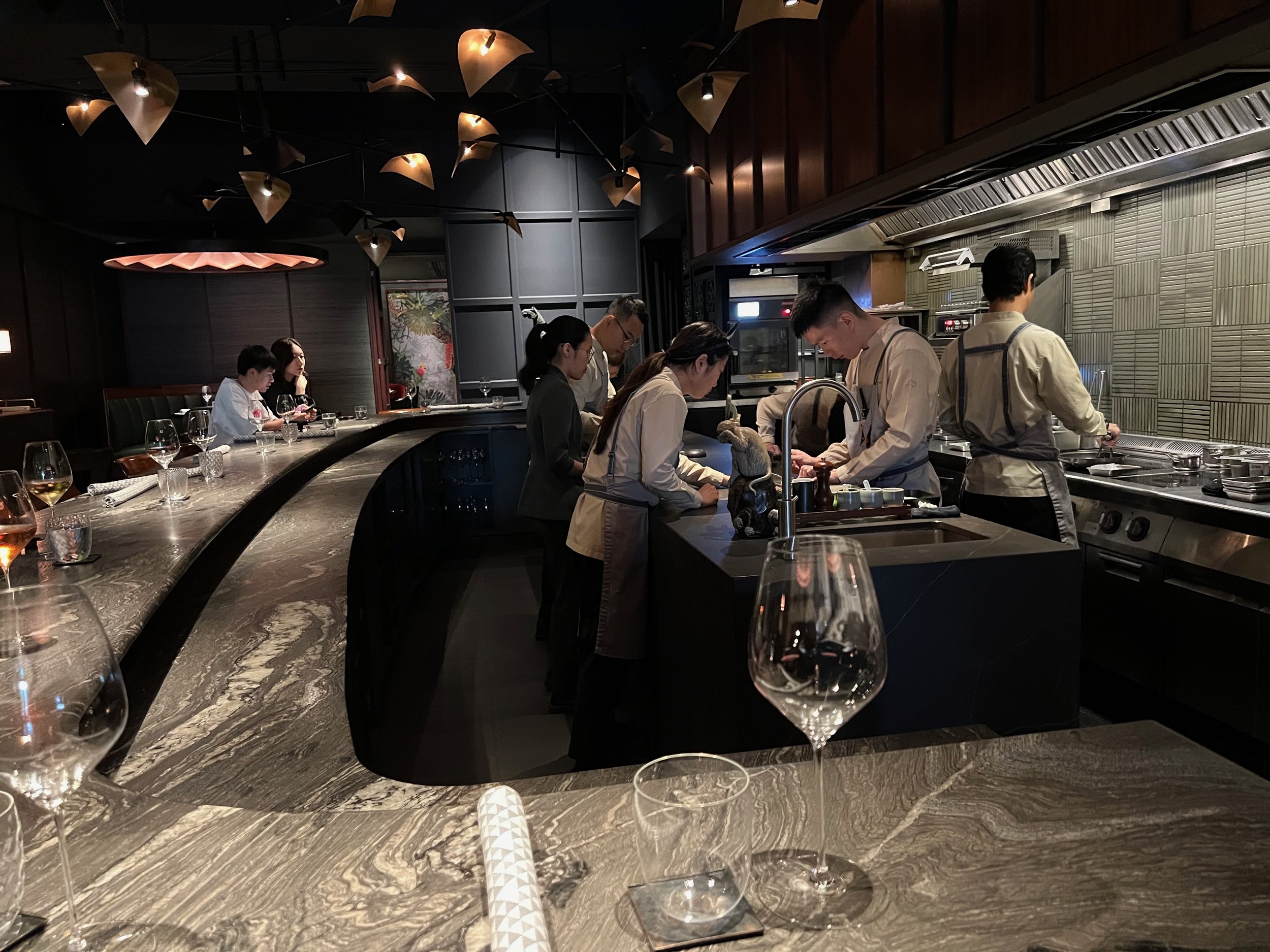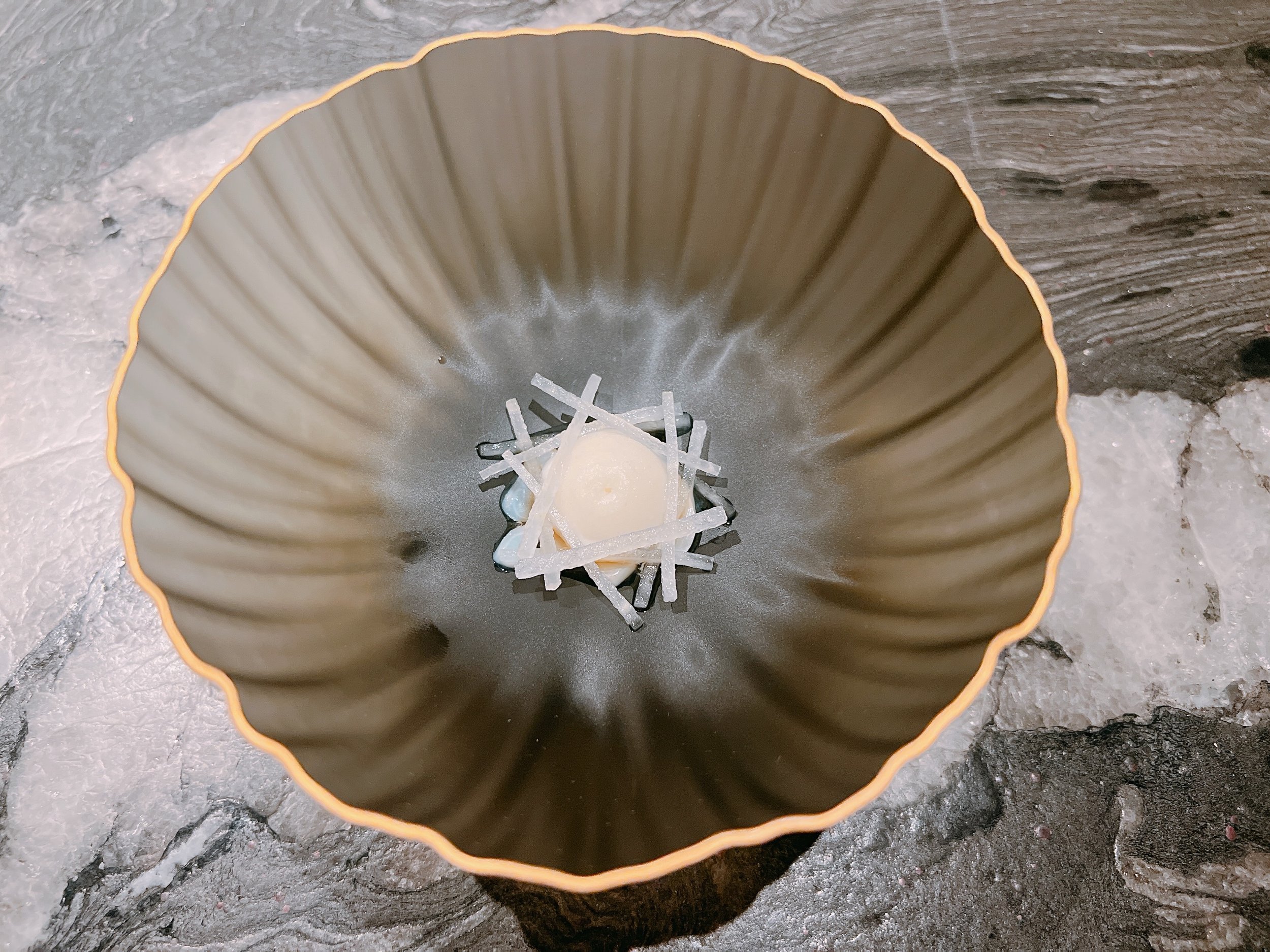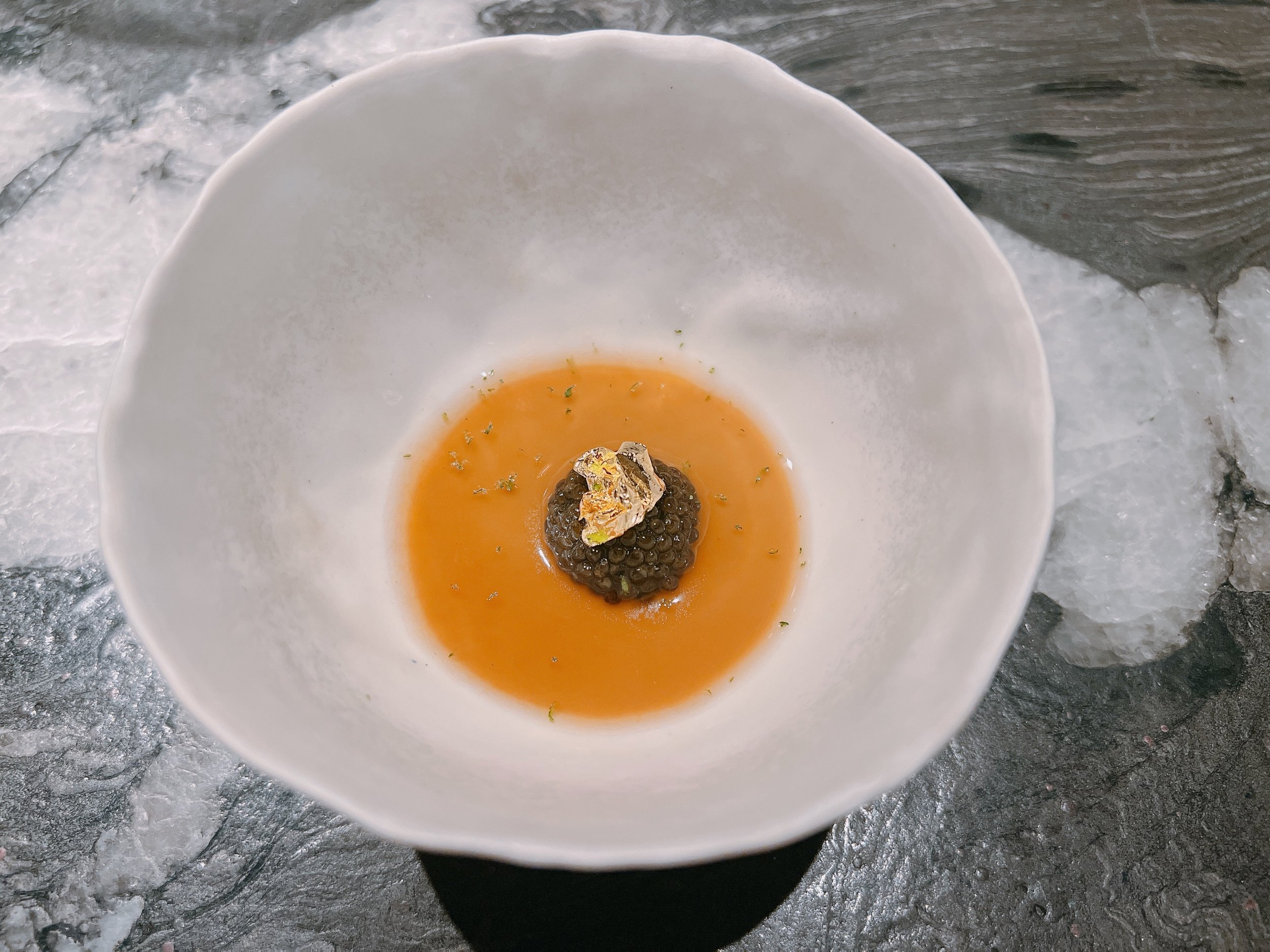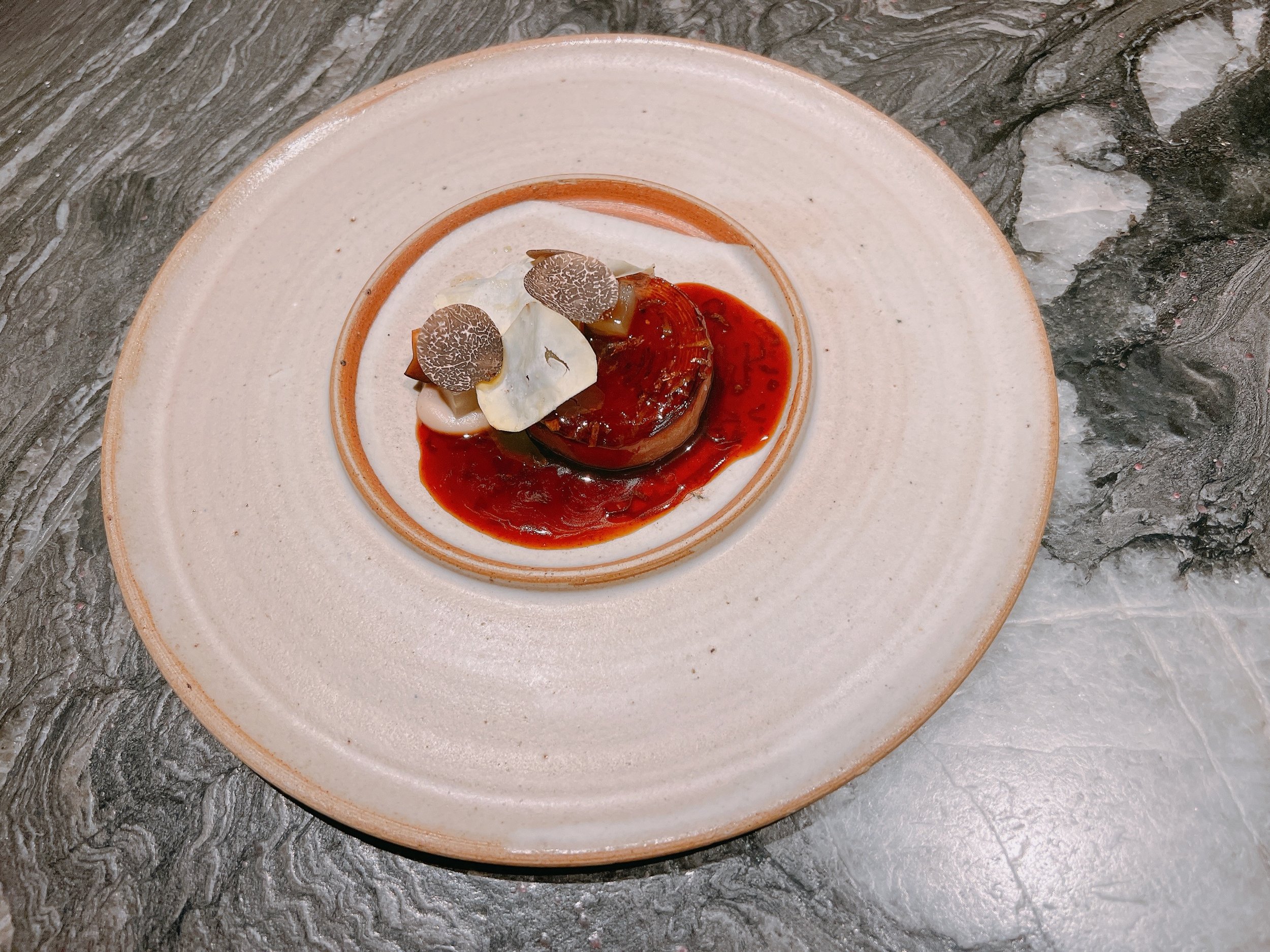Cloudstreet - Singapore
Rating: 16/20
Where: Singapore, Singapore
When: Lunch for 2 on 2 December 2023
Cost per Person: Tasting menu 388 SGD, Wine pairing 268-568 SGD
Accolades: 2 Michelin Stars, #26 on Asia's Top 50 Restaurants list (2023)
Why: French cuisine with Sri Lankan influences
“Cloudstreet”, a two-Michelin-starred restaurant, is located near Singapore's Chinatown in a white colonial building on a street that is seemingly full of restaurants. Contrary to the restaurant’s traditional exterior, its interior follows a simple, modern design with the dominant color being black. It feels a bit like stepping into a club - the relatively loud rock music playing adds to that impression. Most diners sit at a marble counter surrounding the open kitchen, but there are a few tables as well, probably for larger parties. Desserts are served upstairs in a much brighter lounge that has windows facing the street. Moving from one space to another is a bit reminiscent of Zén, which is located only a few streets away. This is probably the best way to make use of the multi-story vintage buildings in this part of Singapore.
The restaurant only serves a tasting menu. During weekday lunches, it is possible to choose a slightly shorter version of the menu. Two wine pairings were on offer, priced at 268 and 568 SGD. We tried both. The more expensive pairing did indeed include some pricey bottles, retailing at $100, $200, or even $400, and ended with a 2001 d'Yquem. Some nice wines for sure, but in terms of enjoyment and matching the food, the cheaper pairing was at least as good if not better, making it the more reasonable choice. Ordering an aperitif is (as so often) a good idea, since the wine pairing only starts after an initial sequence of amuse bouches.
The first amuse bouche was a bbq'ed Australian oyster, served on the half-shell with a sauce made from coconut milk and Thai basil, and topped with finger limes. A refreshing beginning - the acidic finger limes kept this dish light, even over the creaminess of the coconut milk. The oyster unfortunately disappeared a bit in the dish, and the basil leaf was what lingered texture-wise 15.
Served alongside the oyster was a bergamot meringue covered with roasted beetroot and caviar. A mandarin provided some nice acidity, balancing the sweetness of the beets. Add to that some lovely caviar, and you had a winner 17.
Thinly sliced Scottish razor clams were served with pickled root vegetables (kohlrabi and daikon) and a yuzu koshu sorbet. A bit of spice, some acidity, a hint of sweetness, and some crunch provided by the pickles. Sadly, the razor clam was barley noticeable in all of this 16.
Pieces of green lip abalone from Jeju island in South Korea came with basil butter, edamame and a zucchini sabayon. The latter zucchini sauce was delicious and full of flavor - quite an unusual use of zucchini. The abalone was very tender with only a hint of a bite; the edamame provided more crunch. A lovely dish 18.
The final amuse bouche was a porcini custard topped with an onion consommé, a dollop of kaluga caviar and some sudachi. Sadly, this dish didn't taste much of mushrooms, and barely of onions - the latter just added some sweetness. While the caviar was nice, overall this dish felt a bit lackluster 15.
Our first real course was based on a Japanese madai that had been cured and washed in sake. It came with Asian pears, sea succulents, puffed pearl barley, a champagne vinegar foam and fermented pear juice. The fish was good, but unfortunately there was very little of it. However, the rest of the dish made up for it: the sauce was an appealing mix of acidity and a hint of sweetness, and the pears and crunchy barley added some texture. If anything, the sauce was better than the fish. Unfortunately, its sweetness clashed a bit with the bone-dry paired wine - something less dry would probably have been a better match 16.
Next came one of the chef's signature dishes, reportedly on the menu continuously since opening day. A Western Australian crayfish called “marron” had been poached and precut into bite-sized pieces. It was placed on top of a porridge made from millet, coconuts and Sri Lankan spices. Next to it was a tamarind butter and a cup of coconut/lemongrass broth. The crayfish was perfectly cooked, tender and delicious. The millet was nicely spiced (but not spicy). Particularly tasty was the coconut broth, its sourness and creaminess were balanced wonderfully (19 by itself). Overall 17.
Meagre fish was served with a sauce made from crab fat, coconut and lemongrass with a drizzle of kaffir lime powder. It sat on a raisin/chili jam, and was topped with Osetra caviar. This was a lovely dish, where all components went together nicely. The fish was perfectly cooked and quite meaty. There was a nice hint of sweetness from the crab sauce, and the raisin jam was salty and spicy (but not sweet, as one might have expected from its main ingredient). This was an instance where the regular wine pairing was a much better match for this dish than the pricier elevated pairing. The former pairing featured a 23-year-aged Japanese sake that drank like a sherry, the latter a white Burgundy 18.
The first of two meat dishes featured a rolled-up quail next to a chestnut puree, pressed apples, pickled shiitake mushrooms, plums, shaved chestnuts and black truffles. All of this was finished with a truffle jus. This was an autumnal dish, with the quail tasting a bit earthy and the sauce quite lovely. However, even though the pears added some fruitiness, it was a more subdued dish compared to what we had before 16. The pescatarian alternative replaced the quail with a slice of kohlrabi. It had a nice crunch, and resulted in a slightly lighter dish 17.
When restaurants serve bread as a separate course, it's often a bit of a gimmick - why should something that's frequently used to mop up sauces be served on its own? Indeed, we would have loved some bread earlier in our meal for just that reason. But here it made total sense to serve the bread solo. Made with black stout (beer) and licorice, it was brushed with molasses, and served with French butter and salt. The bread was very heavy, dense, and a bit sweet. Adding the butter actually made it seem a bit lighter. Intensely flavorful by itself, the bread would probably have clashed when eaten with another dish 16.
Our final savory course was a two-week-aged Malaysian duck served along a roasted beet filled with cashew butter, and a duck jus with citrus. A cracker made from (and shaped like) a beet sat on top of the cooked beet. The duck was pretty lean (all fat had been rendered), smoky and flavorful, but unfortunately also a bit chewy. Maybe it was the smokiness, but the meat was reminiscent of sausage and/or bacon. The beet added some acidity to the dish, and the cracker was similar to a regular beet chip, albeit much prettier. Overall, another wintry dish 16 (maybe 17 if you like duck more than I do).
Pescatarians received an entirely different dish instead of the duck. Japanese seaperch came with a Kerala style stew made with green chilis, baby artichokes, and samphire. A nicely cooked fish and a light and refined curry 16.
At this point, we were taken upstairs to another lounge, but this one was flooded with light from the large windows facing the street. A palate cleanser of sorts came first. Compressed aloe vera was topped with a shio koji flavored marshmallow and a lingonberry sorbet. The sourness of the lingonberry combined well with the creaminess and flavor of the marshmallow. Quite nice 16.
A mysterious looking black cube was actually a strawberry cake made with pickled rhubarb and topped with strawberry ice cream. That ice cream was excellent and better than the cake itself. The cake's consistency was quite mousse-like and it wasn't particularly sweet - which made it an unfortunate match for the paired port wine. Tasty, but not terribly exciting 15.
Better was a sunchoke ice cream served with poached pears and sheets of crunchy caramelized milk skin. These “crackers” dominated the taste, since the ice cream was only lightly flavored. Crunchy and creamy, yum 16. Given the dessert's lightness, the paired 2001 d'Yquem was a bit too heavy, but who's complaining when drinking one of the most highly rated dessert wines...
Since we had mentioned that my birthday was coming up in a couple days and that we'd be spending it on the beach, we received a coconut cake filled with sea buckthorn and covered with white chocolate. A little figure in a beach outfit sitting on the plate was a nice personalized touch. The cake was quite light, but I liked the slightly acidic addition of sea buckthorn 15.
Three final petit fours concluded our lunch. A bread and butter pudding made with Vegemite was topped by a Vegemite ice cream and paired with a caramel butter cream on the side. (The chef lived in Australia for a while, which explains the somewhat unusual ingredient.) Thankfully (?), there was at most a hint of Vegemite taste. For the most part, this dish was just buttery and, sadly, not too exciting 14. Better was a choux puff filled with a mousse made from coffee and kithul (a Sri Lankan palm sugar). The predominant taste was of coffee 15. Finally, a financier made from ragi (a cereal similar to couscous) was topped with a hazelnut Chantilly cream. It had a nice roasted nutty flavor 15.
Overall: An enjoyable lunch with excellent service. Although the chef hails from Sri Lanka, and there were some culinary touches from his native country, this was mostly a Western (arguably French) cuisine meal. I wish that there had been more Sri Lankan influences, since the best dishes were the ones with more exotic and bolder flavors, whereas the purely Western dishes, such as the meat dishes, were more subdued and less exciting as a result 16.






















